Dear Dakhina,
Now that you live so far away and rarely get the typical Bengali summer vegetables like potol (butter gourd)or jhinge (ridge gourd), do you crave our traditional dishes? If I were in your position I know I would. World cuisine is great but when it comes to comfort food, nothing beats the kind of food our mums make. There was a time right after I got married, when I didn’t know even the basics of Bengali cooking. I knew how to cook non Indian food, while ma had always been in charge of the traditional stuff. Hence, after marriage, most days, come cooking time, I could be found calling up ma long distance, asking for help! It took me years to learn how to make traditional dishes. Meanwhile, Prasanta had to endure watery, tasteless, sometimes burnt, and many times simply inedible food. Innumerable times I have put the rice pan on to boil and simply forgot all about it, till the whole house reeking of charred rice acted a s a rude reminder!
I think I have come a long way since then, although I still burn food quite regularly. That is, I guess my Achilles heel 🙂
Today I wish to share with you a typical regular Bengali lunch menu, which usually starts with a bitter dish called Shukto, lentil dish (dal), a vegetable dish and a non vegetarian dish, which could be fish, meat or eggs in curry form. There are usually accompaniments like fried aubergines. But as we were expecting guests I didn’t make bitter or deep-fried stuff, because it isn’t to everyone’s taste. And to finish the meal we serve a sweet-sour chutney, I made pineapple chutney, which acts as a palate cleanser before the sweet dish without which no Bengali meal is complete. (Today the sweet dish was store bought so it doesn’t feature in this post).
All measurements are for approximately 6 people
Ingredients for Moong Dal (Yellow Split Moong lentil)
2 cup yellow split moong dal, unwashed
1 tsp ghee/white oil
2-3 dry whole red chillies
1 tsp cumin seeds
2 dried bay leaves
1 tsp ginger paste/grated fine
1 tsp sugar
Turmeric powder
Salt to taste
Method For the Dal
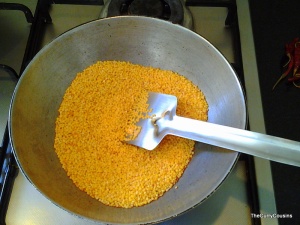
Dry roast the unwashed,lentil in a hot wok, till lightly browned.
Take off the fire. Cool down, and wash well.
In a pressure cooker/pan boil with salt and turmeric till soft (but not mushy) .
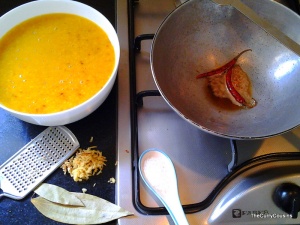
In a wok, heat the ghee /oil
Add the cumin, let it splutter.
Add bay leaves, whole red chillies and ground ginger.
Add the boiled dal and sugar.
Bring to boil.
Your dal is ready to serve.
Tip :
If cooking dal in a pressure cooker, the water level should be an inch above the level of the lentils.
Cook on high flame till two whistle sounds. Let it cool before opening the lid of the cooker.
Ingredients for the vegetable charchari
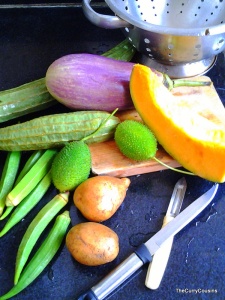
A charchari is a mix of five or more seasonal vegetables. Pumpkins are a must. The rest we use whatever is there at home. The veggies cook in their own juices. This is a very rustic but very flavourful dish. It needs just a little oil to cook and hence is very healthy too.
A chunk of pumpkin, peeled and cubed
2 ridge gourds (jhinge) , peeled and cubed
2 spiky gourds (kakrol) , the skin scrubbed and cubed
1 aubergine, cubed
2 potatoes peeled and cubed
6-8 ladyfingers ( okra) top & tip removed & cut into two
Turmeric
Salt to taste
1 tsp panch phoron.
( Panch phoron is a typical Bengali five spice : to make mix equal quantities of whole cumin, black mustard seeds, nigella seeds (kalonji /kalo jeera), fennel (saunf), fenugreek seeds (methi). Keep this in a bottle and use as a tempering. )
2 tsp oil for cooking
8-10 bori ( small sun dried lentil cakes made from fermented lentil paste) This is an optional garnish
Method
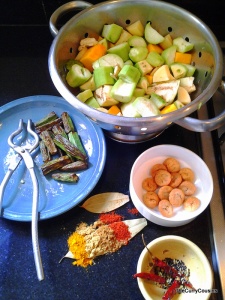
Heat a tsp of oil
Fry the okra in it and keep aside.
In the same oil fry the bori, (if using) and crush coarsely and keep aside.
Take another tsp of oil
Add a tsp of panch phoron.
When it splutters add the vegetables (all except okra)
Add salt and turmeric.
Mix, cover and cook on very low flame till vegetables have sweated their juices and become soft.
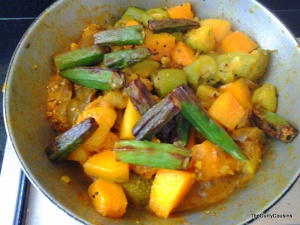
Take off the lid, add the okra and cook on high heat till the juices evaporate. Break down the vegetables a bit.
Take off. Garnish with the crushed bori.
Tip
Cut vegetables all the same size for even cooking.
If the veggies are a few days old they might not sweat too much juice, in which case add a little water.
Okra is not added raw otherwise it goes slimy.
In case you do not find bori, just dry roast a tsp of Panch Phoron, crush it to a powder and sprinkle on the chorchori
Ingredients for Chicken curry
1 kg of chicken, skin removed and cut into medium sized pieces
2 tablespoons curd/yogurt
2 large onions, thinly sliced
1 tablespoon ginger garlic paste
2 tomatoes, cubed
2 tsp cumin powder
2 tsp coriander powder
2 tsp kashmiri chilli powder (for colour)
2 tsp turmeric powder
2 whole green chillies
6 small potatoes, peeled
2 dried bay leaves
2 tablespoons Mustard Oil for cooking /any white oil
Salt to taste
Method
Marinate the chicken in the yogurt
Add half of the ginger garlic paste
1 tsp each of cumin, coriander, chilli and turmeric powders
Add a little salt
Keep aside for half hour
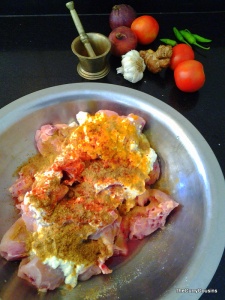
Heat the oil ( Bengalis love Mustard oil, but it is very sharp and an acquired taste)
Fry the potatoes till they are golden brown, pierce with skewer, and keep aside
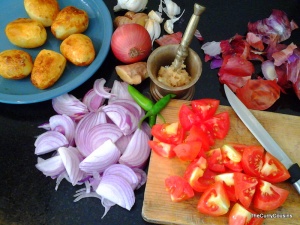
In the same oil add the thinly sliced onions & bay leaves
Fry the onions till soft and a little brown
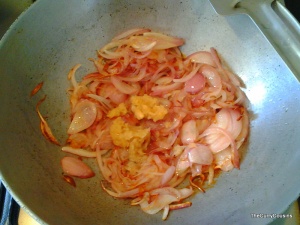
Add the remaining ginger garlic paste, brown
Add the tomatoes and salt and cover. Lower the heat.
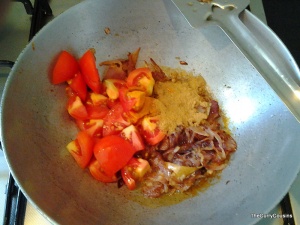
After a few minutes the tomatoes will have broken down,
Add the rest of the dry powder spices and salt.
Cook till oil separates from the Masala.
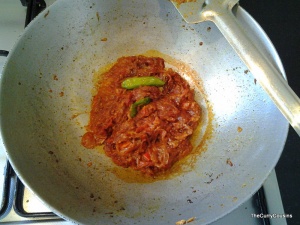
Add the marinated chicken and mix well.
Add the potatoes, cover and cook on low heat.
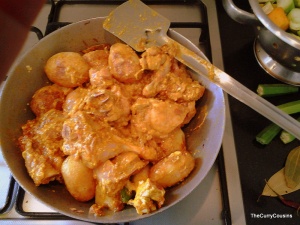
After ten minutes the chicken juices will have come out, stir again.
Cover and cook until the chicken is soft and the oil rises to the top.
Serve with hot steaming plain rice.
Tip
Pierce the potatoes for fast cooking
Cooking the Masala till oil separates is important, otherwise the onions and garlic taste raw.
If needed you can add extra water.
Ingredients for pineapple chutney
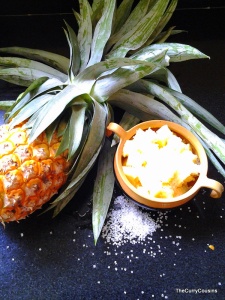
A bowl of chopped ripe pineapple
2 Tablespoons sugar
A few raisins
1 whole dry red chilli
Pinch salt
1/2 tsp flour
1 large cup water
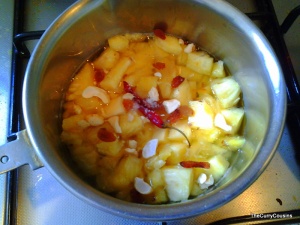
Put all ingredients together in a small pan.
Cover and boil on very low flame till the fruit is softened and the water reduced to half.
Turn up the heat
Add the flour and boil for two minutes.
Remove from heat and cool.
Tip
The amount of sugar depends on the sourness of the fruit, add more if needed. But you want the result to be light, tangy and syrupy.
The flour is a cheat, because less sugar means the syrup is watery, so the flour thickens it just a teeny bit.
The red chilli should not break, you don’t want a hot Chutney, only a hint of spicy heat.
Well , that takes care of three very different recipes. We Indians do not have any fixed recipes with perfect measurement of ingredients. Our preparations differ from house to house, region to region. In some families my recipe may not be considered Bengali enough, especially as I like to use yogurt in cooking my meat, which is more of a Mughal influence. But food is a tradition which stays alive, because of its continuous adaptability. Change something here, tweak something there and you would have started your own tradition!
I hope you do not feel too homesick after reading this post, but as I see it, you can make all three recipes by being adaptable.
Love you
Didi
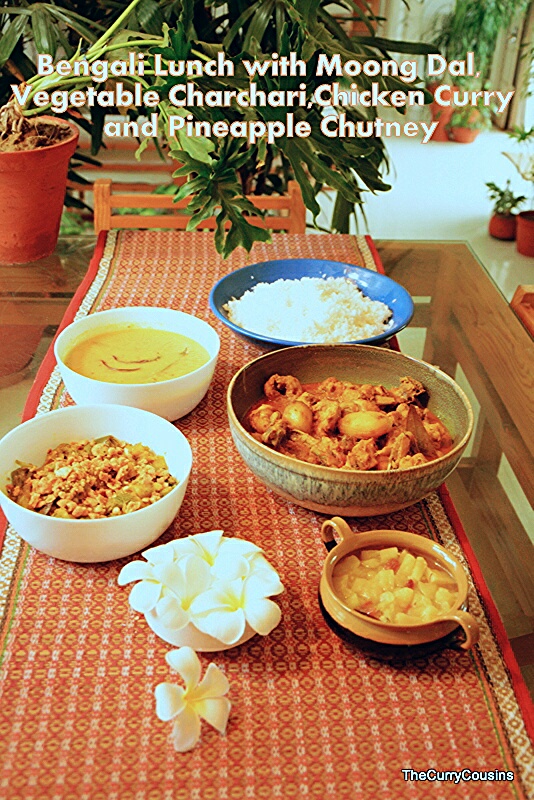
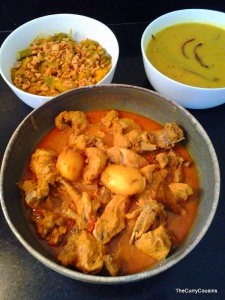
One Comment Add yours